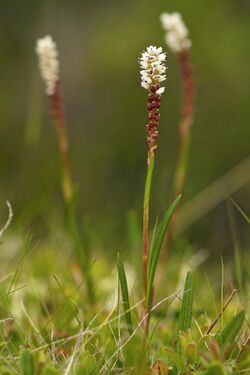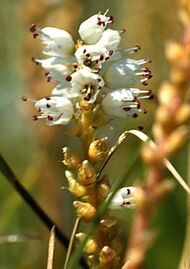Biology:Persicaria vivipara
| Alpine bistort | |
|---|---|

| |
| Scientific classification | |
| Kingdom: | Plantae |
| Clade: | Tracheophytes |
| Clade: | Angiosperms |
| Clade: | Eudicots |
| Order: | Caryophyllales |
| Family: | Polygonaceae |
| Genus: | Persicaria |
| Species: | P. vivipara
|
| Binomial name | |
| Persicaria vivipara (L.) Ronse Decr.
| |
| Synonyms | |
| |
Persicaria vivipara is a perennial herbaceous flowering plant in the knotweed and buckwheat family Polygonaceae, commonly known as alpine bistort. Scientific synonyms include Bistorta vivipara and Polygonum viviparum. It is common all over the high Arctic through Europe, North America, and temperate and tropical Asia.[1] Its range stretches further south in high mountainous areas such as the Alps, Carpathians, Pyrenees, Caucasus, and the Tibetan Plateau.
Taxonomy
Molecular phylogenetic work has demonstrated that the genus Bistorta represents a distinct lineage within the family Polygonaceae.[2] The genus Bistorta contains at least 42 accepted species.[3]
Description

Alpine bistort is a perennial herb that grows to 5 to 15 cm (2 to 6 in) tall. It has a thick rhizomatous rootstock and an erect, unbranched, hairless stem. The leaves are hairless on the upper surfaces, but hairy and greyish-green below. The basal ones are longish-elliptical with long stalks and rounded bases; the upper ones are few and are linear and stalkless. The tiny flowers are white or pink in the upper part of the spike with five perianth segments, eight stamens with purple anthers and three fused carpels. The lower ones are replaced by bulbils. Flowers rarely produce viable seeds and reproduction is normally by the bulbils, which are small bulb-like structures that develop in the axils of the leaves and may develop into new plants. Very often, a small leaf develops when the bulbil is still attached to the mother plant.[4] The bulbils are rich in starch and are a preferred food for rock ptarmigans (Lagopus mutus)[5] and reindeer; they are also occasionally used by Arctic people. Alpine bistort flowers in June and July.[4]
Habitat
Alpine bistort grows in many different plant communities, very often in abundance. Typical habitats include moist short grassland, yards, the edges of tracks, and nutrient-rich fens.[4]
As with many other alpine plants, Alpine bistort is slow-growing and produces embryonic buds one year that grow and open a few years after their formation, with an individual leaf or inflorescence taking three to four years to reach maturity from the time the buds are formed.[6]
Mycorrhiza
Alpine bistort has been shown to form an ectomycorrhizal root symbiosis with fungi.[7]
References
- ↑ {{citation | mode = cs1 | title = Bistorta vivipara (L.) Delarbre | work = Germplasm Resources Information Network (GRIN) | url = https://npgsweb.ars-grin.gov/gringlobal/taxonomydetail.aspx?448785 | publisher = [[Organization:Agricultural Research ServAgricultural Research Service (ARS), United States Department of Agriculture (USDA) | access-date = 11 June 2015 }}
- ↑ "A large-scale phylogeny of Polygonaceae based on molecular data". International Journal of Plant Sciences 170 (8): 1044–1055. 2009. doi:10.1086/605121.
- ↑ "Bistorta". Royal Botanic Gardens, Kew. http://plantsoftheworldonline.org/taxon/urn:lsid:ipni.org:names:331755-2#children. Retrieved 2018-08-06.
- ↑ 4.0 4.1 4.2 "Alpine bistort: Bistorta vivipara". NatureGate. http://www.luontoportti.com/suomi/en/kukkakasvit/alpine-bistort. Retrieved 2013-12-30.
- ↑ "The digestion of bulbils (Polygonum viviparum L.) and berries (Vaccinium myrtillus L. and Empetrum sp.) by captive ptarmigan (Lagopus mutus)". British Journal of Nutrition 33 (2): 197–206. 1975. doi:10.1079/BJN19750024. PMID 1167787.
- ↑ Diggle PK. (1997). "Extreme preformation in alpine Polygonum vivparum: an architectural and developmental analysis". American Journal of Botany 84 (2): 154–169. doi:10.2307/2446077.
- ↑ "Observations on the mycorrhizal status of some alpine plant communities". New Phytologist 88: 341–352. 1981. doi:10.1111/j.1469-8137.1981.tb01729.x.

| Wikimedia Commons has media related to Bistorta vivipara. |
Wikidata ☰ {{{from}}} entry

